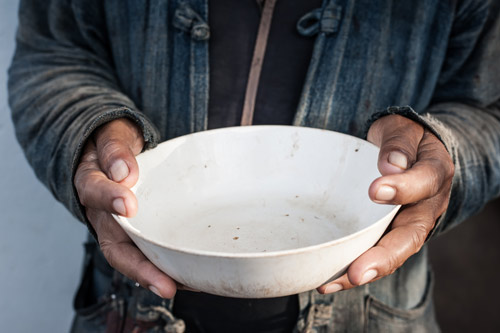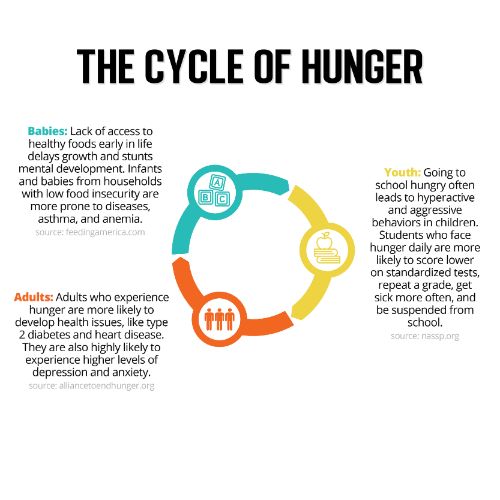In the United States, more than 44 million people, including 13 million children, are considered food insecure. But what exactly is food insecurity?
In this article, we’ll walk through what food insecurity is, who it affects, different programs that were designed to combat food insecurity, and what you can do in the fight against hunger.
What is Food Insecurity?
Food insecurity is defined as “a lack of consistent access to enough food for an active, healthy life.” Food Forward breaks this definition down to explain that food insecurity means that you or your family are worried about paying for groceries, aren’t sure where your next meal might come from, or have to cut back on food in order to pay the bills.
The defining characteristic of low food security is that “food intake of household members is reduced and their normal eating patterns are disrupted because the household lacks money and other resources for food.”

The United States Department of Agriculture (USDA) measures food insecurity in the United States through a national survey that is an addition to the monthly Current Population Survey (CPS). The CPS is a “nationally representative survey conducted by the Bureau of the Census for the Bureau of Labor Statistics. The CPS provides data for the nation's monthly unemployment statistics, and annual income and poverty statistics.” The food insecurity survey contains questions for households to complete that cover a wide range of severity in relation to their food security that year.
In 2020, 10.5% of households in America were considered food insecure, including 3.9% of households reported as having very low food security. The USDA found that food insecure households were more prevalent in the South at 12.3% while the Northeast has the lowest amount of food insecure households at 9.3%.
Food insecurity doesn’t have an income qualification, although it is closely associated with poverty. However, not all people living below the poverty line are considered food insecure and people who live above the poverty line are still susceptible to food insecurity.
The Ranges of Food Insecurity
According to the U.S. Department of Agriculture (USDA), there are 4 tiers to food security. Being classified as “food secure” consists of the top 2 tiers - high food security and marginal food security. Being considered “food insecure” consists of the bottom 2 tiers - low food security and very low food security.
Each household is placed somewhere within those four tiers. Here’s how it’s broken down:
- Very Low Food Security: households in this tier reported eating patterns were disrupted by one or more household members due to a lack of money and resources to access adequate food.
- Low Food Security: households in this tier reported reduced quality and variety of foods, but their access to an adequate amount of food was not significantly impacted.
- Marginal Food Security: households in this tier reported some uncertainty of access to food at some point, but ultimately the quality, variety, and amount of food they had access to weren’t substantially impacted.
- High Food Security: households in this tier reported having consistent access to adequate food.
In 2021, 89.8% of households were classified as food secure households. 6.4% of households were classified as low food security, and very low food security households were at 3.8%.
What is Poverty?
Poverty is defined as “a human condition characterized by sustained or chronic deprivation of the resources, capabilities, choices, security, and power necessary for the enjoyment of an adequate standard of living and other civil, cultural, economic, political and social rights."
In simpler terms, it means having little to no income and the inability to provide basic needs, like shelter, food, and security.
According to the United States Census Bureau, over 34 million Americans lived in poverty in 2021. Poverty is measured based on a household's income level, the number of people in the household, and the ages of people in the household. The 2023 poverty guidelines for the United States, not including Alaska and Hawaii, is at $30,000 for a family of four.
Living in poverty can severely impact the quality of life for those living through it. If a family is struggling to make ends meet and there isn’t access to food, medicine, and other necessities during pregnancy, a fetus doesn’t thrive and could be born at low birth weight.

As a child grows into the infant stage, they may suffer from delayed growth and experience frequent sickness. Stunted physical and mental development may occur during the toddler years. School-aged children can face learning difficulties or may even find themselves unable to attend school. The effects of poverty can follow a child into adulthood, leading to chronic illness and lack of education or the ability to work.
There is also a wide range of negative psychological effects caused by poverty. Children are at a greater risk of behavioral and emotional problems, which could include impulsiveness, difficulty getting along with peers, aggression, attention-deficit/hyperactivity disorder, and conduct disorder. There may also be intense feelings of anxiety, depression, and low self-esteem.
Parents may face chronic symptoms from the effects of poverty like stress and depression. Married couples may also feel marital distress and exhibit tougher parenting behaviors when living in poverty.
Living in poverty doesn’t automatically mean you’re food insecure, and being considered food insecure doesn’t mean you live in poverty. According to Feeding America, in 2021, about 38 million people live in households with concern for affording food, but 59% of those people earn incomes above the poverty line. Simultaneously, about 37 million people live below the poverty line, yet 61% report being food secure.
The poverty line for a family of 4 in 2021 was around $26,500 annually, leaving about a quarter of food insecure people are not eligible for any federal food assistance programs, like WIC or SNAP.
Who Does Food Insecurity Affect?
Food insecurity affects every community in the United States, but it more commonly affects marginalized communities, like minority groups, women, children, veterans, senior citizens, and the LGBTQ+ community.
On average, Black people are 2 times more likely to experience poverty and food insecurity than the overall population of the United States. Over 30% of single moms face food insecurity, compared to 11% of all households, and 1 in 4 veterans of the Iraq and Afghanistan wars is food insecure. Additionally, millions of college students are being forced to choose between eating and paying for their tuition.
Programs that Combat Food Insecurity
In the United States, there are a handful of programs that have been implemented to reduce the burden of food insecurity on households. Those programs include the Supplemental Nutrition Assistance Program (SNAP), Women, Infants, and Children (WIC), the National School Lunch Program (NSLP), and the School Breakfast Program (SBP).
The Supplemental Nutrition Assistance Program (SNAP), formerly known as Food Stamps, is considered the largest food and nutrition assistance program in the United States, with over 42 million participants. The majority of participants in the program are families with children, seniors, or disabled individuals. Over 85 percent of SNAP benefits go to households that include children, seniors, or disabled individuals. A total of 92 percent of SNAP benefits go to households at or below the federal poverty level.
SNAP was developed to provide financial assistance for nutritional needs with the hope that low-income individuals and families would be able to afford their other needs, like rent, transportation, utilities, and medical bills. Learn more about the SNAP program and eligibility requirements here.
Women, Infant, and Children (WIC) is a government program specifically designed for low-income pregnant women, post-partum women, women with infants, and young children up to the age of 5. WIC provides formula for non-breastfeeding parents, as well as nutritional needs with WIC-authorized foods, which include infant cereal, baby foods, fresh fruits and vegetables, milk, whole grain options, and more.
WIC also provides more than access to food, but also to resources like health screenings, breastfeeding support, immunizations, and more. Find out more about WIC and if you qualify for the program here.
The National School Lunch Program (NLSP) and the School Breakfast Program (SBP) are programs focused on ensuring more than 30 million low-income students have access to school lunches for a reduced price or at no cost, depending on where their households fall on the income scale.
For high-poverty school districts, the additional Community Eligibility Provision allows schools across the country to offer lunch AND breakfast at no charge to all students attending the school - no forms required. Currently, more than 100,000 schools are part of this program. Find out more about these programs here.
What Can We Do?
Food insecurity can impact anybody - even you. Move For Hunger is working hard with partner organizations to fight hunger throughout America, but we need all the help we can get!
Hosting a food drive or fundraiser to raise donations for food banks and pantries is also always a great option to join the fight against hunger! This helps make sure local food insecure communities have access to meals and food banks have well-stocked shelves.
We also need to strengthen our federal nutrition programs. The National School Lunch Program, the School Breakfast Program, the Summer Food Service Program, WIC, and SNAP safeguard low-income individuals and families from the dangers of hunger and poverty. We all need to advocate for and support these life-saving programs.
If you’d like to make an impact immediately, consider donating today! A donation as small as $25 feeds 63 people.
